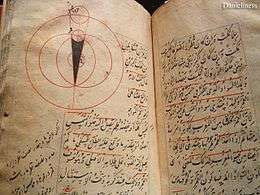Jaghmini
Mahmūd ibn Muḥammad ibn Umar al-Jaghmini, or 'al-Chaghmīnī', or al-Jaghmini, was a 13th or 14th-century Persian physician, astronomer and author of the Qanunshah (The Canon of Medicine) a short epitome of by Avicenna in Persian, and Mulakhkhas (Summary), a work on astronomy completed in 808 AH - 1405/6 AD.

Life
Little of him is known beyond what is indicated by his name, that he was a native of Jaghmin, a village in Khwarezm (Khiva), current day Uzbekistan. Confusion over the date of his death also exists as both 1344 and 1221[n 1] have been cited.
Qanunshah
The popularity of the Qanunshah may be indicated by the number of scholarly commentaries it produced. Two were by contemporaries of his, the scientists Ghazī Zade Rūmi and Mīr Seyed Sharīf Gorganī. Several versefied versions were also produced and considerable evidence exists of its use in medical teaching in the eastern provinces of the Islamic world.
Mulakhkhas
The celebrated Ottoman-Turkish historian Haji Khalifa, in his biographic account contained in Sullam al-Wusūl, mentions reading al-Jaghmini's Mulakhkhas, together with another astronomical work, Ashkal al-ta'sis[n 2] by Shams al-Din Muhammad ibn Ashraf al-Samarqandi, with his tutor A'rej Mehmed Efendi, between the years 1643-45 AD. A treatise by Musa ibn Muhammad Qadizade al-Rumi (fl. AH 815/1412 AD) called Sharh al- mulakhas fi al-hay'a (Compendium of the Science of Astronomy, seems to have been a commentary on it.[1]
Notes
- An author by the same name who wrote Sharh al- mulakhas fi al-hay'a cites this earlier date.
- Geometrical work on Euclid's 35 propositions. Musa ibn Muhammad Qadizade also wrote a commentary on the work.
References
- Kâtip Çelebi 1957, pp. 141, 154, Balance of Truth.
Sources
- Kâtip Çelebi (1957). Balance of Truth. Translated by G.L. Lewis. London: George Allen & Unwin Ltd. pp. 141, 154.CS1 maint: ref=harv (link)
Bibliography
For a discussion of his popular epitome, the Qanuncheh, and the use made of it by subsequent generations of medical students, see:
- A. Z. Iskandar, A Catalogue of Arabic Manuscripts on Medicine and Science in the Wellcome Historical Medical Library (London: The Wellcome Historical Medical Library, 1967), pp. 56–64.
- C.A. Storey, Persian Literature: A Bio-Bibliographical Survey. Volume II, Part 1: A. Mathematics, B. Weights and Measures, C. Astronomy and Astrology, D. Geography (London: Luzac, 1958), p. 219.
- Carl Brockelmann, Geschichte der arabischen Litteratur, 1st edition, 2 vols. (Leiden: Brill, 1889-1936). Second edition, 2 vols. (Leiden: Brill, 1943–49). Page references will be to those of the first edition, with the 2nd edition page numbers given in parentheses, p. 473 (625)
- Carl Brockelmann, Geschichte der arabischen Litteratur, Supplement, 3 vols. (Leiden: Brill, 1937-1942). vol. 1, p. 865.
- Manfred Ullmann, Die Medizin im Islam, Handbuch der Orientalistik, Abteilung I, Ergänzungsband vi, Abschnitt 1 (Leiden: E.J. Brill, 1970), p. 154 note 4.
- Lutz Richter-Bernburg, Persian Medical Manuscripts at the University of California, Los Angeles: A Descriptive Catalogue, Humana Civilitas, vol. 4 (Malibu: Udena Publications, 1978), p. 28.
- C.A. Storey, Persian Literature: A Bio-Bibliographical Survey. Volume II, Part 1: A. Mathematics, B. Weights and Measures, C. Astronomy and Astrology, D. Geography (London: Luzac, 1958), p. 50 no. 88.
See also
- List of Iranian scientists
External links
- Ragep, Sally P. (2007). "Jaghmīnī: Sharaf al‐Dīn Maḥmūd ibn Muḥammad ibn ʿUmar al‐Jaghmīnī al‐Khwārizmī". In Thomas Hockey; et al. (eds.). The Biographical Encyclopedia of Astronomers. New York: Springer. pp. 584–5. ISBN 978-0-387-31022-0. (PDF version)